Evaluating Talent Management Strategies at Sainsbury's Project
VerifiedAdded on 2022/12/26
|35
|7662
|71
Project
AI Summary
This research project investigates the effectiveness of talent management strategies employed by Sainsbury's in retaining and attracting high-performance employees and team leaders. It explores various talent management strategies used by the organization, analyzing their importance in fostering employee retention and attracting new talent. The study also identifies potential issues that Sainsbury's might face due to ineffective talent management practices. The research methodology involves both secondary data from publications and journals, and primary data collected through questionnaires. The findings highlight the importance of training, employee engagement, and strategic human resource management in achieving organizational goals and maintaining a competitive edge. The project concludes with recommendations for Sainsbury's to optimize its talent management strategies for sustained success. Desklib provides access to this solved assignment and a wealth of other study resources.
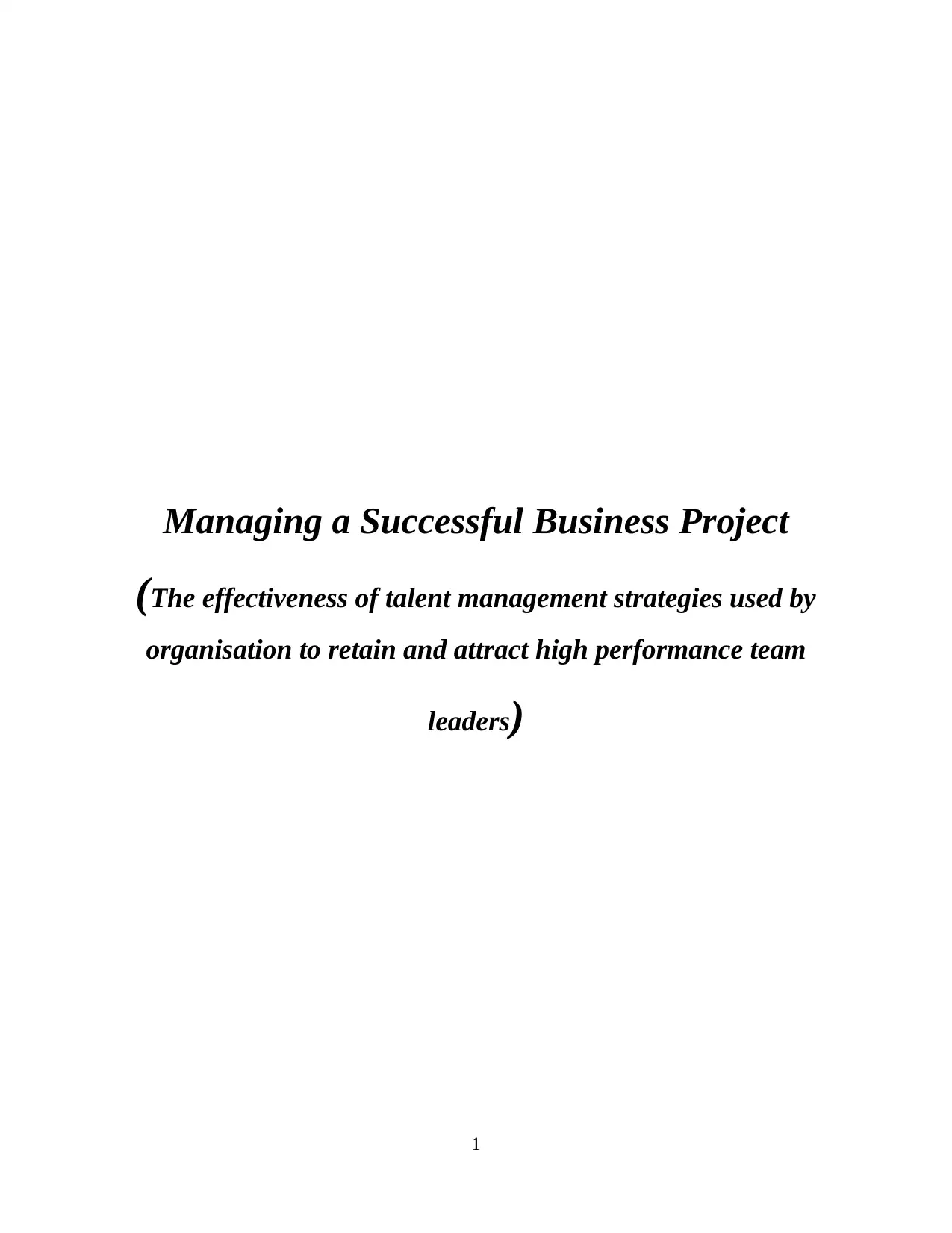
Managing a Successful Business Project
(The effectiveness of talent management strategies used by
organisation to retain and attract high performance team
leaders)
1
(The effectiveness of talent management strategies used by
organisation to retain and attract high performance team
leaders)
1
Paraphrase This Document
Need a fresh take? Get an instant paraphrase of this document with our AI Paraphraser
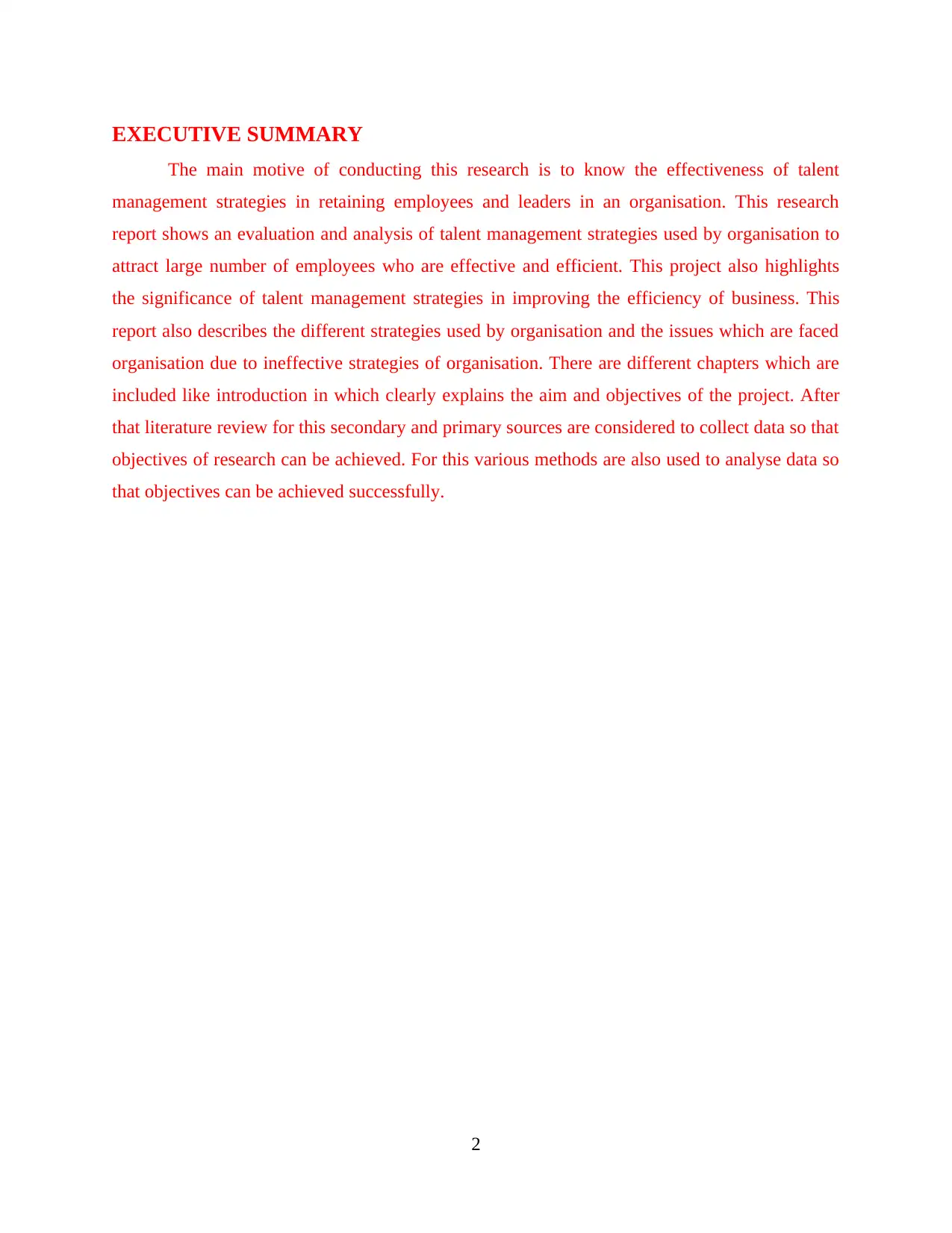
EXECUTIVE SUMMARY
The main motive of conducting this research is to know the effectiveness of talent
management strategies in retaining employees and leaders in an organisation. This research
report shows an evaluation and analysis of talent management strategies used by organisation to
attract large number of employees who are effective and efficient. This project also highlights
the significance of talent management strategies in improving the efficiency of business. This
report also describes the different strategies used by organisation and the issues which are faced
organisation due to ineffective strategies of organisation. There are different chapters which are
included like introduction in which clearly explains the aim and objectives of the project. After
that literature review for this secondary and primary sources are considered to collect data so that
objectives of research can be achieved. For this various methods are also used to analyse data so
that objectives can be achieved successfully.
2
The main motive of conducting this research is to know the effectiveness of talent
management strategies in retaining employees and leaders in an organisation. This research
report shows an evaluation and analysis of talent management strategies used by organisation to
attract large number of employees who are effective and efficient. This project also highlights
the significance of talent management strategies in improving the efficiency of business. This
report also describes the different strategies used by organisation and the issues which are faced
organisation due to ineffective strategies of organisation. There are different chapters which are
included like introduction in which clearly explains the aim and objectives of the project. After
that literature review for this secondary and primary sources are considered to collect data so that
objectives of research can be achieved. For this various methods are also used to analyse data so
that objectives can be achieved successfully.
2
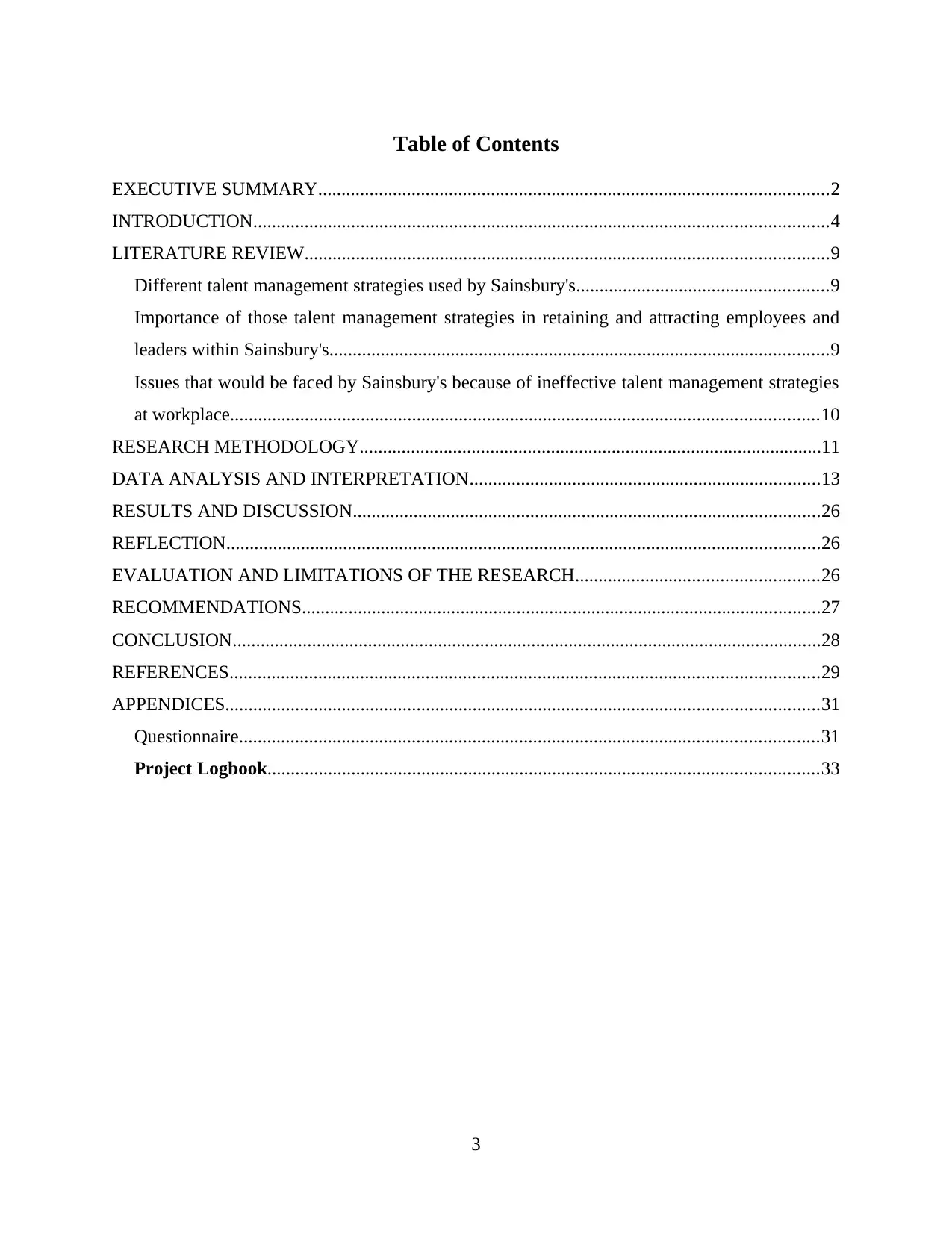
Table of Contents
EXECUTIVE SUMMARY.............................................................................................................2
INTRODUCTION...........................................................................................................................4
LITERATURE REVIEW................................................................................................................9
Different talent management strategies used by Sainsbury's......................................................9
Importance of those talent management strategies in retaining and attracting employees and
leaders within Sainsbury's...........................................................................................................9
Issues that would be faced by Sainsbury's because of ineffective talent management strategies
at workplace..............................................................................................................................10
RESEARCH METHODOLOGY...................................................................................................11
DATA ANALYSIS AND INTERPRETATION...........................................................................13
RESULTS AND DISCUSSION....................................................................................................26
REFLECTION...............................................................................................................................26
EVALUATION AND LIMITATIONS OF THE RESEARCH....................................................26
RECOMMENDATIONS...............................................................................................................27
CONCLUSION..............................................................................................................................28
REFERENCES..............................................................................................................................29
APPENDICES...............................................................................................................................31
Questionnaire............................................................................................................................31
Project Logbook......................................................................................................................33
3
EXECUTIVE SUMMARY.............................................................................................................2
INTRODUCTION...........................................................................................................................4
LITERATURE REVIEW................................................................................................................9
Different talent management strategies used by Sainsbury's......................................................9
Importance of those talent management strategies in retaining and attracting employees and
leaders within Sainsbury's...........................................................................................................9
Issues that would be faced by Sainsbury's because of ineffective talent management strategies
at workplace..............................................................................................................................10
RESEARCH METHODOLOGY...................................................................................................11
DATA ANALYSIS AND INTERPRETATION...........................................................................13
RESULTS AND DISCUSSION....................................................................................................26
REFLECTION...............................................................................................................................26
EVALUATION AND LIMITATIONS OF THE RESEARCH....................................................26
RECOMMENDATIONS...............................................................................................................27
CONCLUSION..............................................................................................................................28
REFERENCES..............................................................................................................................29
APPENDICES...............................................................................................................................31
Questionnaire............................................................................................................................31
Project Logbook......................................................................................................................33
3
⊘ This is a preview!⊘
Do you want full access?
Subscribe today to unlock all pages.

Trusted by 1+ million students worldwide
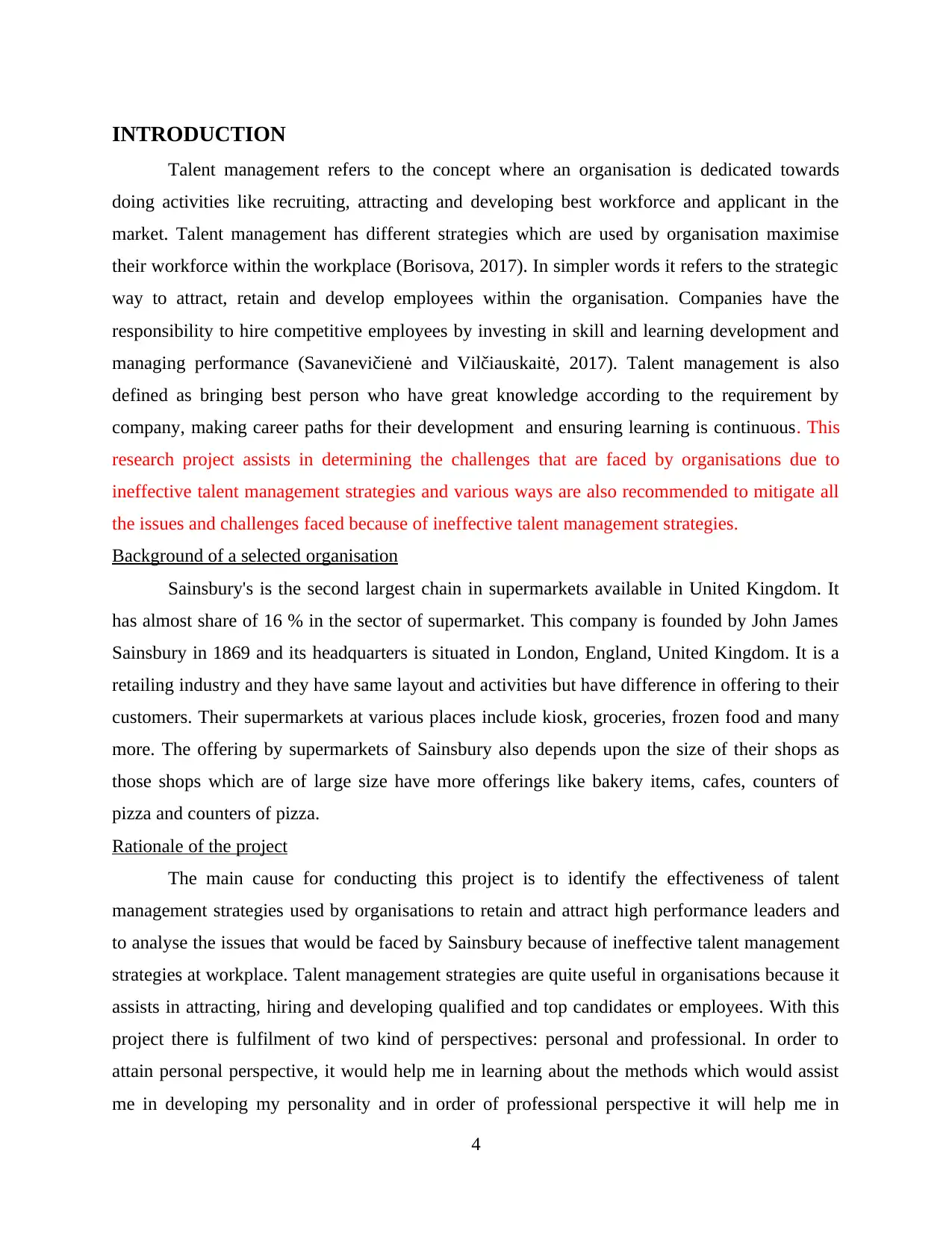
INTRODUCTION
Talent management refers to the concept where an organisation is dedicated towards
doing activities like recruiting, attracting and developing best workforce and applicant in the
market. Talent management has different strategies which are used by organisation maximise
their workforce within the workplace (Borisova, 2017). In simpler words it refers to the strategic
way to attract, retain and develop employees within the organisation. Companies have the
responsibility to hire competitive employees by investing in skill and learning development and
managing performance (Savanevičienė and Vilčiauskaitė, 2017). Talent management is also
defined as bringing best person who have great knowledge according to the requirement by
company, making career paths for their development and ensuring learning is continuous. This
research project assists in determining the challenges that are faced by organisations due to
ineffective talent management strategies and various ways are also recommended to mitigate all
the issues and challenges faced because of ineffective talent management strategies.
Background of a selected organisation
Sainsbury's is the second largest chain in supermarkets available in United Kingdom. It
has almost share of 16 % in the sector of supermarket. This company is founded by John James
Sainsbury in 1869 and its headquarters is situated in London, England, United Kingdom. It is a
retailing industry and they have same layout and activities but have difference in offering to their
customers. Their supermarkets at various places include kiosk, groceries, frozen food and many
more. The offering by supermarkets of Sainsbury also depends upon the size of their shops as
those shops which are of large size have more offerings like bakery items, cafes, counters of
pizza and counters of pizza.
Rationale of the project
The main cause for conducting this project is to identify the effectiveness of talent
management strategies used by organisations to retain and attract high performance leaders and
to analyse the issues that would be faced by Sainsbury because of ineffective talent management
strategies at workplace. Talent management strategies are quite useful in organisations because it
assists in attracting, hiring and developing qualified and top candidates or employees. With this
project there is fulfilment of two kind of perspectives: personal and professional. In order to
attain personal perspective, it would help me in learning about the methods which would assist
me in developing my personality and in order of professional perspective it will help me in
4
Talent management refers to the concept where an organisation is dedicated towards
doing activities like recruiting, attracting and developing best workforce and applicant in the
market. Talent management has different strategies which are used by organisation maximise
their workforce within the workplace (Borisova, 2017). In simpler words it refers to the strategic
way to attract, retain and develop employees within the organisation. Companies have the
responsibility to hire competitive employees by investing in skill and learning development and
managing performance (Savanevičienė and Vilčiauskaitė, 2017). Talent management is also
defined as bringing best person who have great knowledge according to the requirement by
company, making career paths for their development and ensuring learning is continuous. This
research project assists in determining the challenges that are faced by organisations due to
ineffective talent management strategies and various ways are also recommended to mitigate all
the issues and challenges faced because of ineffective talent management strategies.
Background of a selected organisation
Sainsbury's is the second largest chain in supermarkets available in United Kingdom. It
has almost share of 16 % in the sector of supermarket. This company is founded by John James
Sainsbury in 1869 and its headquarters is situated in London, England, United Kingdom. It is a
retailing industry and they have same layout and activities but have difference in offering to their
customers. Their supermarkets at various places include kiosk, groceries, frozen food and many
more. The offering by supermarkets of Sainsbury also depends upon the size of their shops as
those shops which are of large size have more offerings like bakery items, cafes, counters of
pizza and counters of pizza.
Rationale of the project
The main cause for conducting this project is to identify the effectiveness of talent
management strategies used by organisations to retain and attract high performance leaders and
to analyse the issues that would be faced by Sainsbury because of ineffective talent management
strategies at workplace. Talent management strategies are quite useful in organisations because it
assists in attracting, hiring and developing qualified and top candidates or employees. With this
project there is fulfilment of two kind of perspectives: personal and professional. In order to
attain personal perspective, it would help me in learning about the methods which would assist
me in developing my personality and in order of professional perspective it will help me in
4
Paraphrase This Document
Need a fresh take? Get an instant paraphrase of this document with our AI Paraphraser
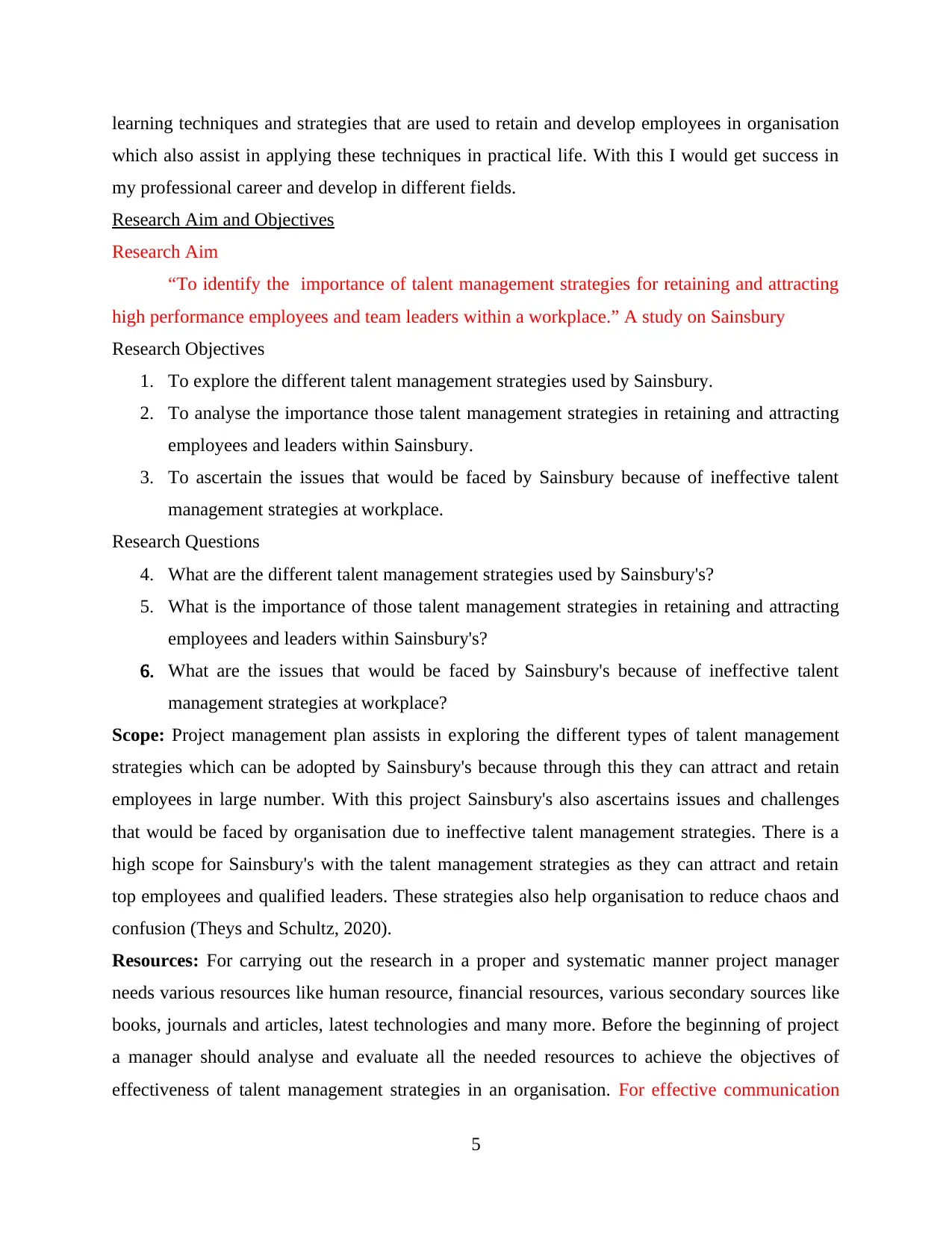
learning techniques and strategies that are used to retain and develop employees in organisation
which also assist in applying these techniques in practical life. With this I would get success in
my professional career and develop in different fields.
Research Aim and Objectives
Research Aim
“To identify the importance of talent management strategies for retaining and attracting
high performance employees and team leaders within a workplace.” A study on Sainsbury
Research Objectives
1. To explore the different talent management strategies used by Sainsbury.
2. To analyse the importance those talent management strategies in retaining and attracting
employees and leaders within Sainsbury.
3. To ascertain the issues that would be faced by Sainsbury because of ineffective talent
management strategies at workplace.
Research Questions
4. What are the different talent management strategies used by Sainsbury's?
5. What is the importance of those talent management strategies in retaining and attracting
employees and leaders within Sainsbury's?
6. What are the issues that would be faced by Sainsbury's because of ineffective talent
management strategies at workplace?
Scope: Project management plan assists in exploring the different types of talent management
strategies which can be adopted by Sainsbury's because through this they can attract and retain
employees in large number. With this project Sainsbury's also ascertains issues and challenges
that would be faced by organisation due to ineffective talent management strategies. There is a
high scope for Sainsbury's with the talent management strategies as they can attract and retain
top employees and qualified leaders. These strategies also help organisation to reduce chaos and
confusion (Theys and Schultz, 2020).
Resources: For carrying out the research in a proper and systematic manner project manager
needs various resources like human resource, financial resources, various secondary sources like
books, journals and articles, latest technologies and many more. Before the beginning of project
a manager should analyse and evaluate all the needed resources to achieve the objectives of
effectiveness of talent management strategies in an organisation. For effective communication
5
which also assist in applying these techniques in practical life. With this I would get success in
my professional career and develop in different fields.
Research Aim and Objectives
Research Aim
“To identify the importance of talent management strategies for retaining and attracting
high performance employees and team leaders within a workplace.” A study on Sainsbury
Research Objectives
1. To explore the different talent management strategies used by Sainsbury.
2. To analyse the importance those talent management strategies in retaining and attracting
employees and leaders within Sainsbury.
3. To ascertain the issues that would be faced by Sainsbury because of ineffective talent
management strategies at workplace.
Research Questions
4. What are the different talent management strategies used by Sainsbury's?
5. What is the importance of those talent management strategies in retaining and attracting
employees and leaders within Sainsbury's?
6. What are the issues that would be faced by Sainsbury's because of ineffective talent
management strategies at workplace?
Scope: Project management plan assists in exploring the different types of talent management
strategies which can be adopted by Sainsbury's because through this they can attract and retain
employees in large number. With this project Sainsbury's also ascertains issues and challenges
that would be faced by organisation due to ineffective talent management strategies. There is a
high scope for Sainsbury's with the talent management strategies as they can attract and retain
top employees and qualified leaders. These strategies also help organisation to reduce chaos and
confusion (Theys and Schultz, 2020).
Resources: For carrying out the research in a proper and systematic manner project manager
needs various resources like human resource, financial resources, various secondary sources like
books, journals and articles, latest technologies and many more. Before the beginning of project
a manager should analyse and evaluate all the needed resources to achieve the objectives of
effectiveness of talent management strategies in an organisation. For effective communication
5
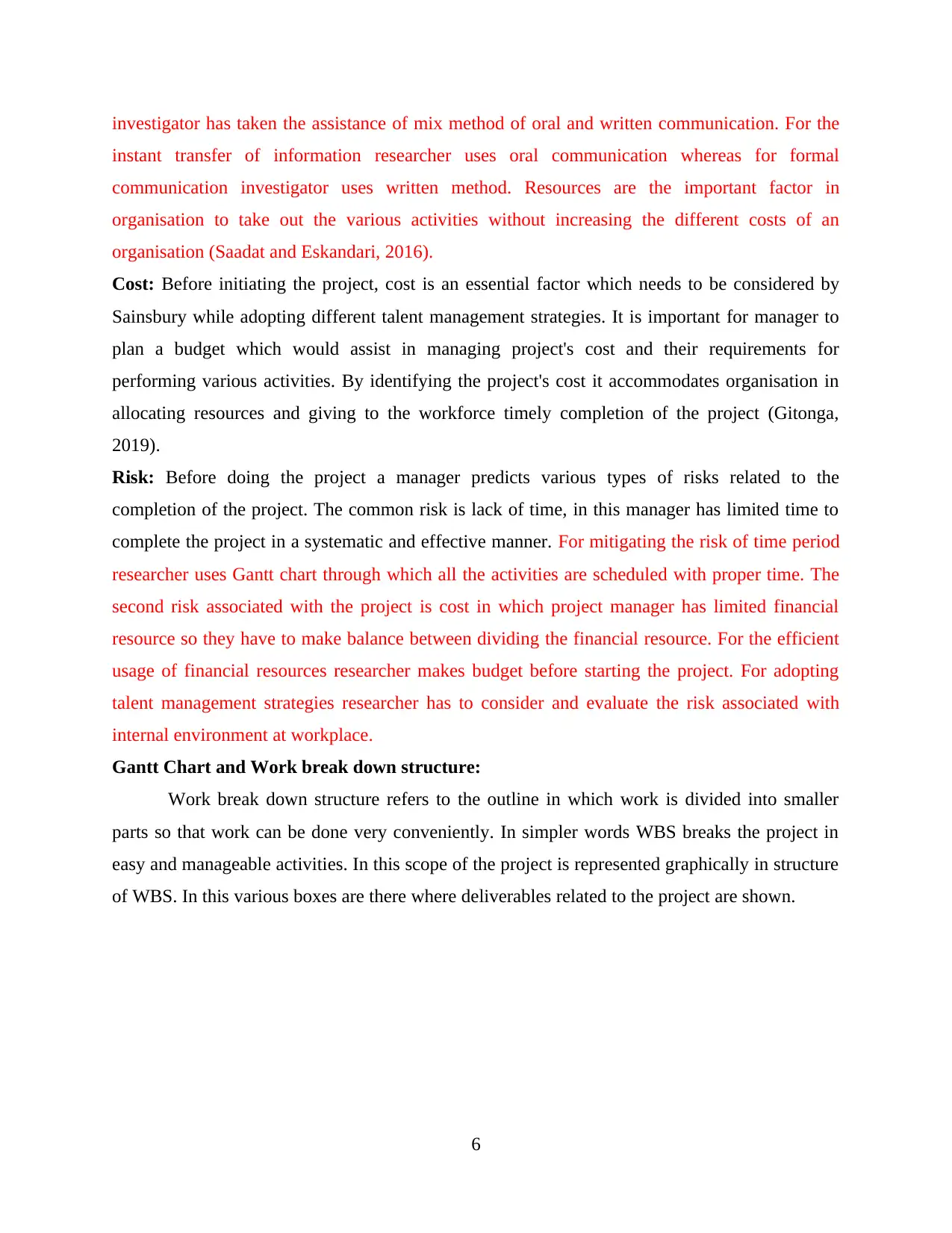
investigator has taken the assistance of mix method of oral and written communication. For the
instant transfer of information researcher uses oral communication whereas for formal
communication investigator uses written method. Resources are the important factor in
organisation to take out the various activities without increasing the different costs of an
organisation (Saadat and Eskandari, 2016).
Cost: Before initiating the project, cost is an essential factor which needs to be considered by
Sainsbury while adopting different talent management strategies. It is important for manager to
plan a budget which would assist in managing project's cost and their requirements for
performing various activities. By identifying the project's cost it accommodates organisation in
allocating resources and giving to the workforce timely completion of the project (Gitonga,
2019).
Risk: Before doing the project a manager predicts various types of risks related to the
completion of the project. The common risk is lack of time, in this manager has limited time to
complete the project in a systematic and effective manner. For mitigating the risk of time period
researcher uses Gantt chart through which all the activities are scheduled with proper time. The
second risk associated with the project is cost in which project manager has limited financial
resource so they have to make balance between dividing the financial resource. For the efficient
usage of financial resources researcher makes budget before starting the project. For adopting
talent management strategies researcher has to consider and evaluate the risk associated with
internal environment at workplace.
Gantt Chart and Work break down structure:
Work break down structure refers to the outline in which work is divided into smaller
parts so that work can be done very conveniently. In simpler words WBS breaks the project in
easy and manageable activities. In this scope of the project is represented graphically in structure
of WBS. In this various boxes are there where deliverables related to the project are shown.
6
instant transfer of information researcher uses oral communication whereas for formal
communication investigator uses written method. Resources are the important factor in
organisation to take out the various activities without increasing the different costs of an
organisation (Saadat and Eskandari, 2016).
Cost: Before initiating the project, cost is an essential factor which needs to be considered by
Sainsbury while adopting different talent management strategies. It is important for manager to
plan a budget which would assist in managing project's cost and their requirements for
performing various activities. By identifying the project's cost it accommodates organisation in
allocating resources and giving to the workforce timely completion of the project (Gitonga,
2019).
Risk: Before doing the project a manager predicts various types of risks related to the
completion of the project. The common risk is lack of time, in this manager has limited time to
complete the project in a systematic and effective manner. For mitigating the risk of time period
researcher uses Gantt chart through which all the activities are scheduled with proper time. The
second risk associated with the project is cost in which project manager has limited financial
resource so they have to make balance between dividing the financial resource. For the efficient
usage of financial resources researcher makes budget before starting the project. For adopting
talent management strategies researcher has to consider and evaluate the risk associated with
internal environment at workplace.
Gantt Chart and Work break down structure:
Work break down structure refers to the outline in which work is divided into smaller
parts so that work can be done very conveniently. In simpler words WBS breaks the project in
easy and manageable activities. In this scope of the project is represented graphically in structure
of WBS. In this various boxes are there where deliverables related to the project are shown.
6
⊘ This is a preview!⊘
Do you want full access?
Subscribe today to unlock all pages.

Trusted by 1+ million students worldwide
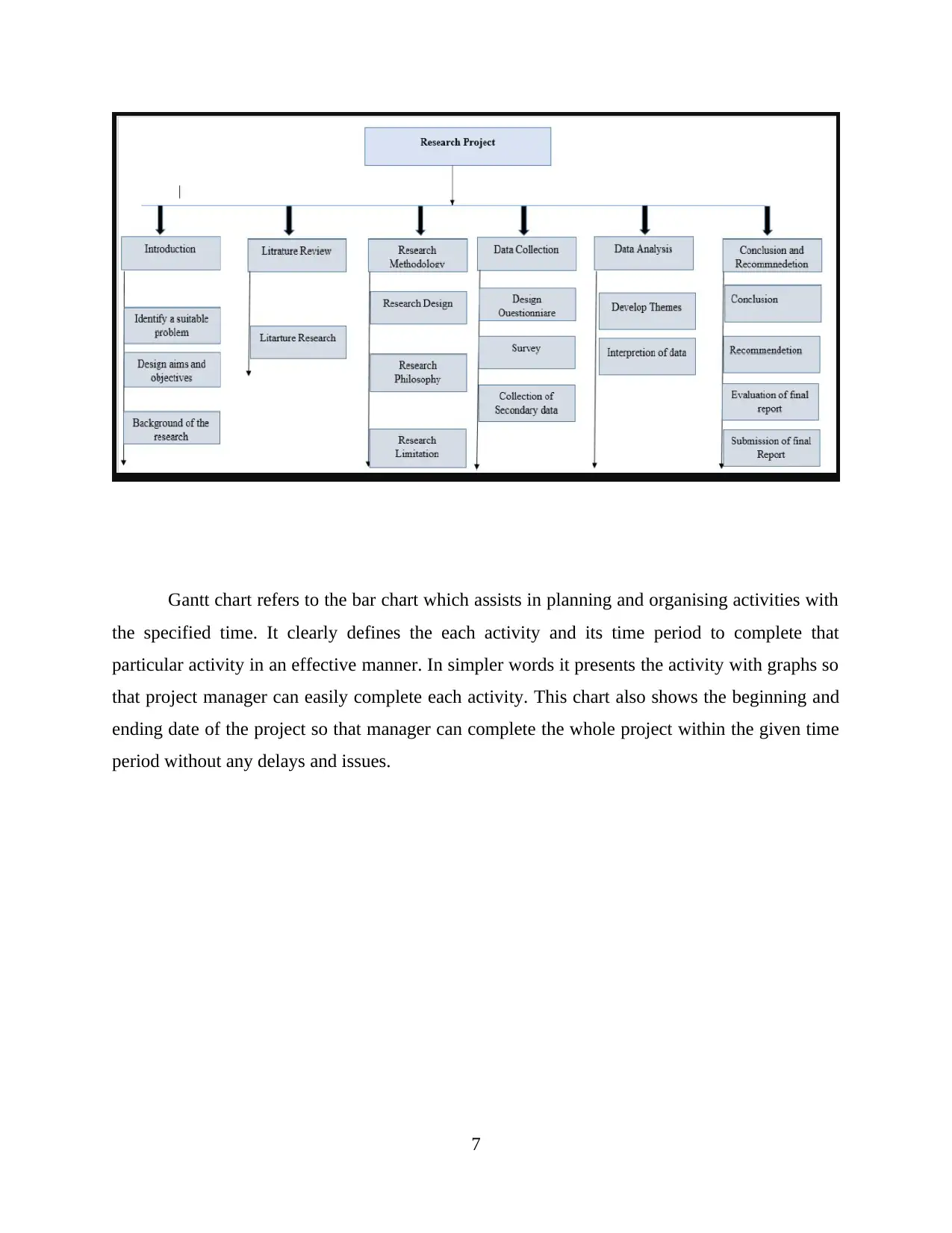
Gantt chart refers to the bar chart which assists in planning and organising activities with
the specified time. It clearly defines the each activity and its time period to complete that
particular activity in an effective manner. In simpler words it presents the activity with graphs so
that project manager can easily complete each activity. This chart also shows the beginning and
ending date of the project so that manager can complete the whole project within the given time
period without any delays and issues.
7
the specified time. It clearly defines the each activity and its time period to complete that
particular activity in an effective manner. In simpler words it presents the activity with graphs so
that project manager can easily complete each activity. This chart also shows the beginning and
ending date of the project so that manager can complete the whole project within the given time
period without any delays and issues.
7
Paraphrase This Document
Need a fresh take? Get an instant paraphrase of this document with our AI Paraphraser
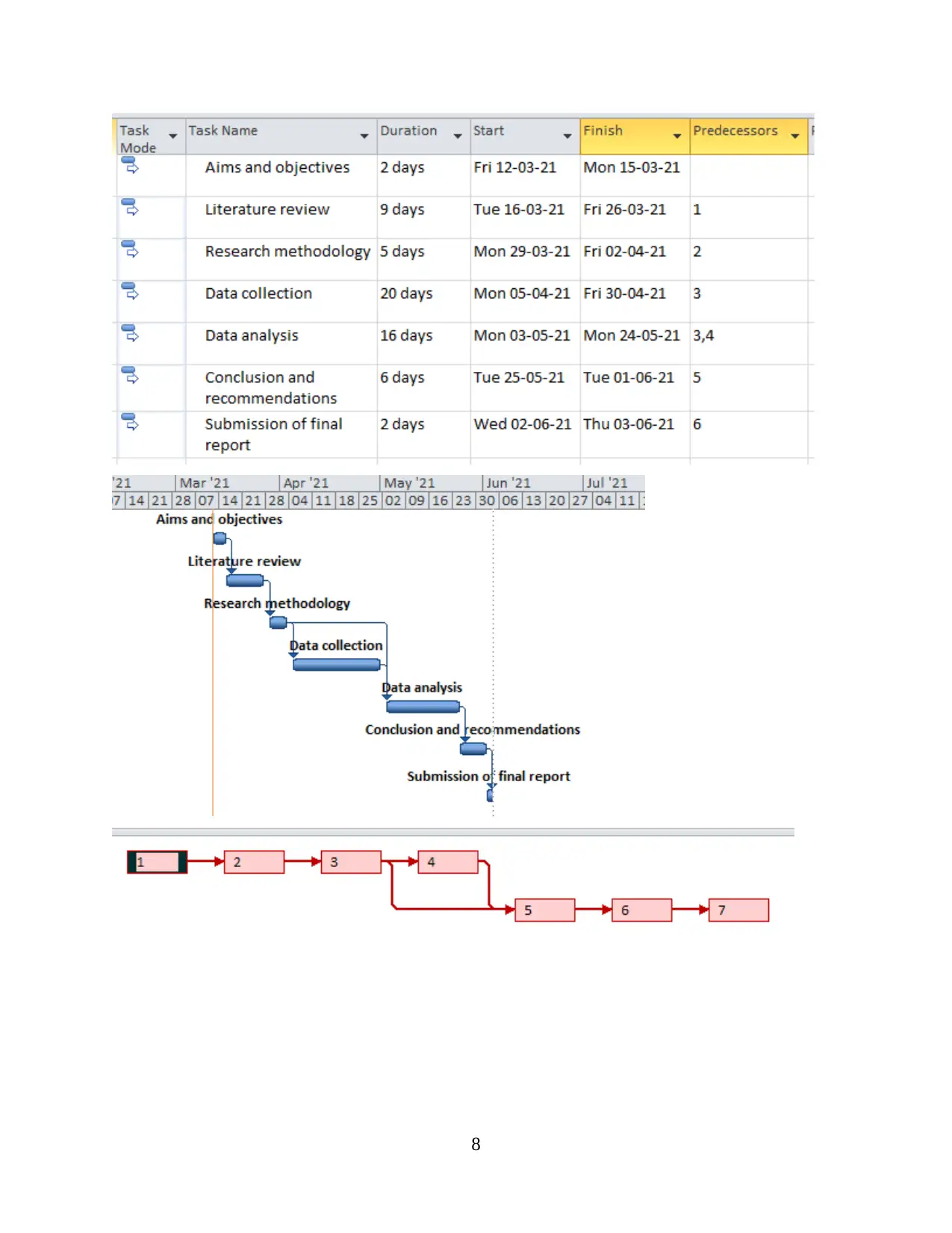
8
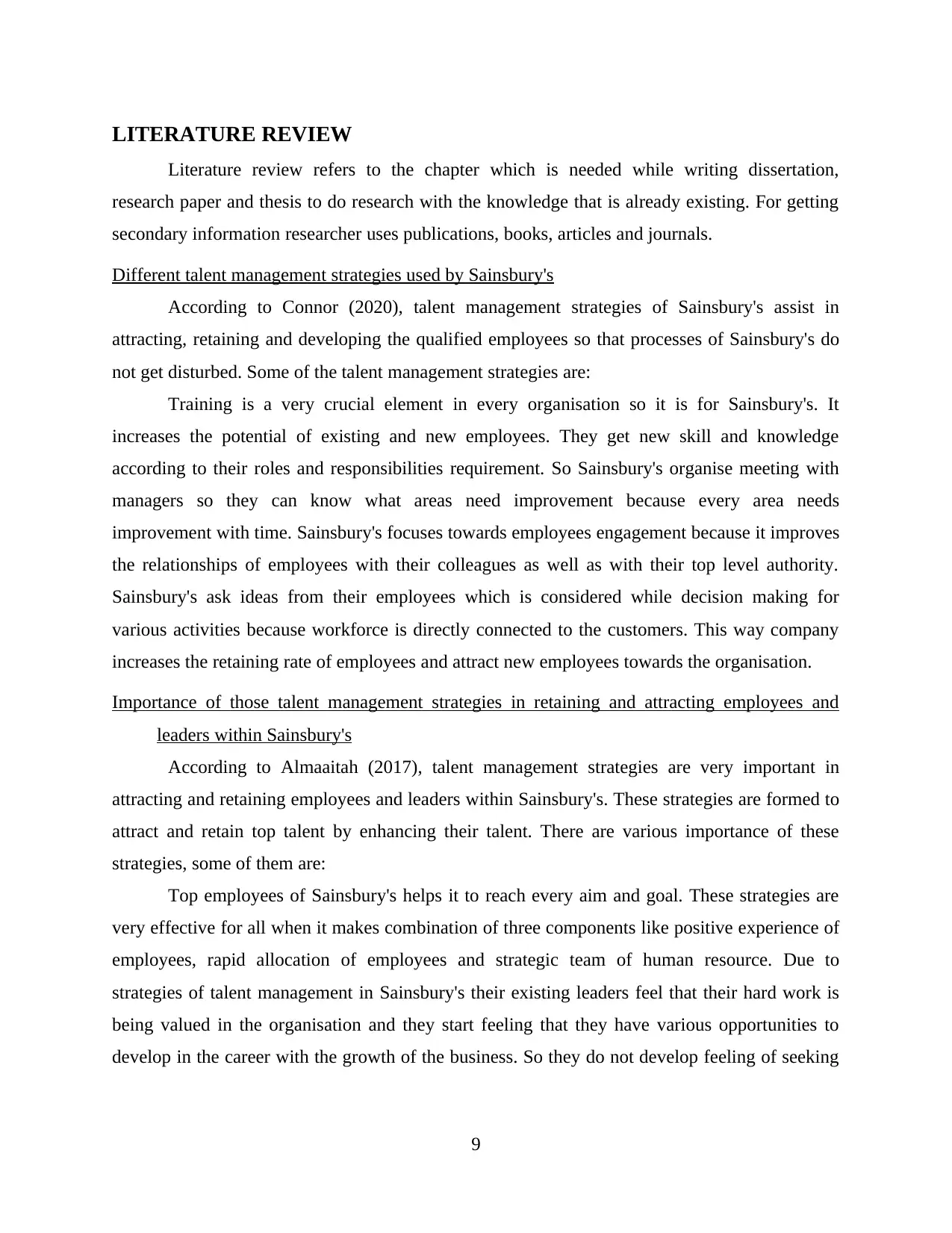
LITERATURE REVIEW
Literature review refers to the chapter which is needed while writing dissertation,
research paper and thesis to do research with the knowledge that is already existing. For getting
secondary information researcher uses publications, books, articles and journals.
Different talent management strategies used by Sainsbury's
According to Connor (2020), talent management strategies of Sainsbury's assist in
attracting, retaining and developing the qualified employees so that processes of Sainsbury's do
not get disturbed. Some of the talent management strategies are:
Training is a very crucial element in every organisation so it is for Sainsbury's. It
increases the potential of existing and new employees. They get new skill and knowledge
according to their roles and responsibilities requirement. So Sainsbury's organise meeting with
managers so they can know what areas need improvement because every area needs
improvement with time. Sainsbury's focuses towards employees engagement because it improves
the relationships of employees with their colleagues as well as with their top level authority.
Sainsbury's ask ideas from their employees which is considered while decision making for
various activities because workforce is directly connected to the customers. This way company
increases the retaining rate of employees and attract new employees towards the organisation.
Importance of those talent management strategies in retaining and attracting employees and
leaders within Sainsbury's
According to Almaaitah (2017), talent management strategies are very important in
attracting and retaining employees and leaders within Sainsbury's. These strategies are formed to
attract and retain top talent by enhancing their talent. There are various importance of these
strategies, some of them are:
Top employees of Sainsbury's helps it to reach every aim and goal. These strategies are
very effective for all when it makes combination of three components like positive experience of
employees, rapid allocation of employees and strategic team of human resource. Due to
strategies of talent management in Sainsbury's their existing leaders feel that their hard work is
being valued in the organisation and they start feeling that they have various opportunities to
develop in the career with the growth of the business. So they do not develop feeling of seeking
9
Literature review refers to the chapter which is needed while writing dissertation,
research paper and thesis to do research with the knowledge that is already existing. For getting
secondary information researcher uses publications, books, articles and journals.
Different talent management strategies used by Sainsbury's
According to Connor (2020), talent management strategies of Sainsbury's assist in
attracting, retaining and developing the qualified employees so that processes of Sainsbury's do
not get disturbed. Some of the talent management strategies are:
Training is a very crucial element in every organisation so it is for Sainsbury's. It
increases the potential of existing and new employees. They get new skill and knowledge
according to their roles and responsibilities requirement. So Sainsbury's organise meeting with
managers so they can know what areas need improvement because every area needs
improvement with time. Sainsbury's focuses towards employees engagement because it improves
the relationships of employees with their colleagues as well as with their top level authority.
Sainsbury's ask ideas from their employees which is considered while decision making for
various activities because workforce is directly connected to the customers. This way company
increases the retaining rate of employees and attract new employees towards the organisation.
Importance of those talent management strategies in retaining and attracting employees and
leaders within Sainsbury's
According to Almaaitah (2017), talent management strategies are very important in
attracting and retaining employees and leaders within Sainsbury's. These strategies are formed to
attract and retain top talent by enhancing their talent. There are various importance of these
strategies, some of them are:
Top employees of Sainsbury's helps it to reach every aim and goal. These strategies are
very effective for all when it makes combination of three components like positive experience of
employees, rapid allocation of employees and strategic team of human resource. Due to
strategies of talent management in Sainsbury's their existing leaders feel that their hard work is
being valued in the organisation and they start feeling that they have various opportunities to
develop in the career with the growth of the business. So they do not develop feeling of seeking
9
⊘ This is a preview!⊘
Do you want full access?
Subscribe today to unlock all pages.

Trusted by 1+ million students worldwide
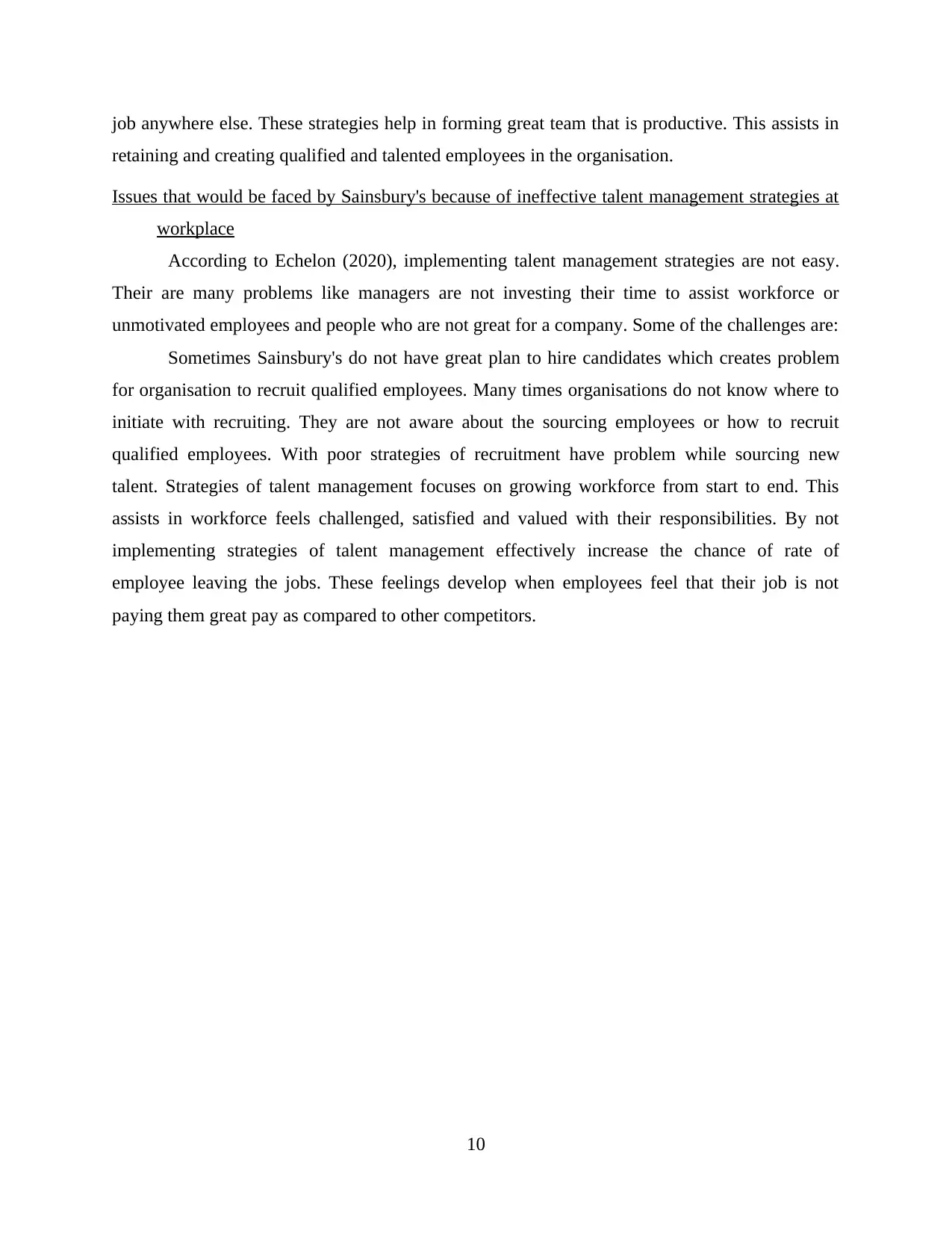
job anywhere else. These strategies help in forming great team that is productive. This assists in
retaining and creating qualified and talented employees in the organisation.
Issues that would be faced by Sainsbury's because of ineffective talent management strategies at
workplace
According to Echelon (2020), implementing talent management strategies are not easy.
Their are many problems like managers are not investing their time to assist workforce or
unmotivated employees and people who are not great for a company. Some of the challenges are:
Sometimes Sainsbury's do not have great plan to hire candidates which creates problem
for organisation to recruit qualified employees. Many times organisations do not know where to
initiate with recruiting. They are not aware about the sourcing employees or how to recruit
qualified employees. With poor strategies of recruitment have problem while sourcing new
talent. Strategies of talent management focuses on growing workforce from start to end. This
assists in workforce feels challenged, satisfied and valued with their responsibilities. By not
implementing strategies of talent management effectively increase the chance of rate of
employee leaving the jobs. These feelings develop when employees feel that their job is not
paying them great pay as compared to other competitors.
10
retaining and creating qualified and talented employees in the organisation.
Issues that would be faced by Sainsbury's because of ineffective talent management strategies at
workplace
According to Echelon (2020), implementing talent management strategies are not easy.
Their are many problems like managers are not investing their time to assist workforce or
unmotivated employees and people who are not great for a company. Some of the challenges are:
Sometimes Sainsbury's do not have great plan to hire candidates which creates problem
for organisation to recruit qualified employees. Many times organisations do not know where to
initiate with recruiting. They are not aware about the sourcing employees or how to recruit
qualified employees. With poor strategies of recruitment have problem while sourcing new
talent. Strategies of talent management focuses on growing workforce from start to end. This
assists in workforce feels challenged, satisfied and valued with their responsibilities. By not
implementing strategies of talent management effectively increase the chance of rate of
employee leaving the jobs. These feelings develop when employees feel that their job is not
paying them great pay as compared to other competitors.
10
Paraphrase This Document
Need a fresh take? Get an instant paraphrase of this document with our AI Paraphraser
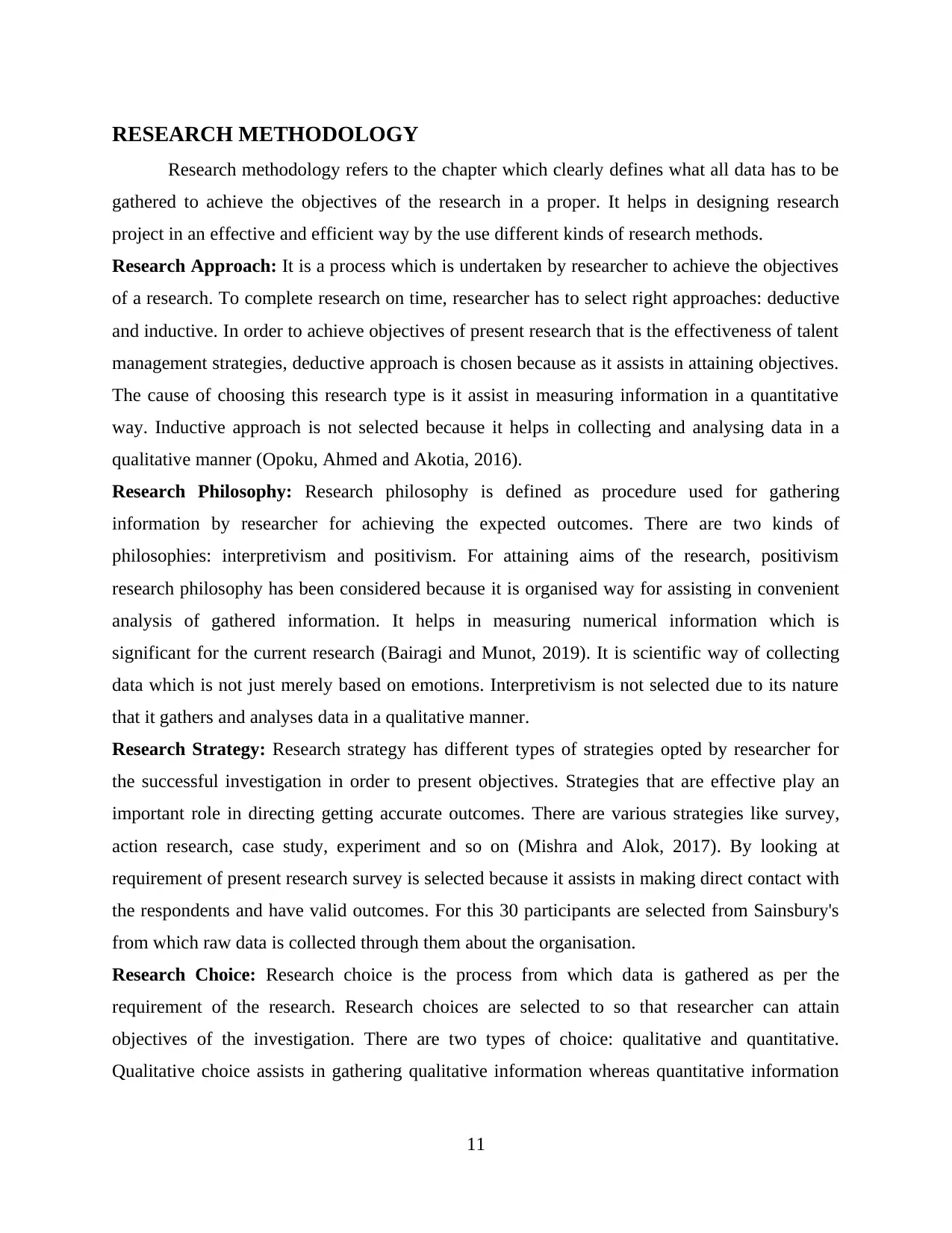
RESEARCH METHODOLOGY
Research methodology refers to the chapter which clearly defines what all data has to be
gathered to achieve the objectives of the research in a proper. It helps in designing research
project in an effective and efficient way by the use different kinds of research methods.
Research Approach: It is a process which is undertaken by researcher to achieve the objectives
of a research. To complete research on time, researcher has to select right approaches: deductive
and inductive. In order to achieve objectives of present research that is the effectiveness of talent
management strategies, deductive approach is chosen because as it assists in attaining objectives.
The cause of choosing this research type is it assist in measuring information in a quantitative
way. Inductive approach is not selected because it helps in collecting and analysing data in a
qualitative manner (Opoku, Ahmed and Akotia, 2016).
Research Philosophy: Research philosophy is defined as procedure used for gathering
information by researcher for achieving the expected outcomes. There are two kinds of
philosophies: interpretivism and positivism. For attaining aims of the research, positivism
research philosophy has been considered because it is organised way for assisting in convenient
analysis of gathered information. It helps in measuring numerical information which is
significant for the current research (Bairagi and Munot, 2019). It is scientific way of collecting
data which is not just merely based on emotions. Interpretivism is not selected due to its nature
that it gathers and analyses data in a qualitative manner.
Research Strategy: Research strategy has different types of strategies opted by researcher for
the successful investigation in order to present objectives. Strategies that are effective play an
important role in directing getting accurate outcomes. There are various strategies like survey,
action research, case study, experiment and so on (Mishra and Alok, 2017). By looking at
requirement of present research survey is selected because it assists in making direct contact with
the respondents and have valid outcomes. For this 30 participants are selected from Sainsbury's
from which raw data is collected through them about the organisation.
Research Choice: Research choice is the process from which data is gathered as per the
requirement of the research. Research choices are selected to so that researcher can attain
objectives of the investigation. There are two types of choice: qualitative and quantitative.
Qualitative choice assists in gathering qualitative information whereas quantitative information
11
Research methodology refers to the chapter which clearly defines what all data has to be
gathered to achieve the objectives of the research in a proper. It helps in designing research
project in an effective and efficient way by the use different kinds of research methods.
Research Approach: It is a process which is undertaken by researcher to achieve the objectives
of a research. To complete research on time, researcher has to select right approaches: deductive
and inductive. In order to achieve objectives of present research that is the effectiveness of talent
management strategies, deductive approach is chosen because as it assists in attaining objectives.
The cause of choosing this research type is it assist in measuring information in a quantitative
way. Inductive approach is not selected because it helps in collecting and analysing data in a
qualitative manner (Opoku, Ahmed and Akotia, 2016).
Research Philosophy: Research philosophy is defined as procedure used for gathering
information by researcher for achieving the expected outcomes. There are two kinds of
philosophies: interpretivism and positivism. For attaining aims of the research, positivism
research philosophy has been considered because it is organised way for assisting in convenient
analysis of gathered information. It helps in measuring numerical information which is
significant for the current research (Bairagi and Munot, 2019). It is scientific way of collecting
data which is not just merely based on emotions. Interpretivism is not selected due to its nature
that it gathers and analyses data in a qualitative manner.
Research Strategy: Research strategy has different types of strategies opted by researcher for
the successful investigation in order to present objectives. Strategies that are effective play an
important role in directing getting accurate outcomes. There are various strategies like survey,
action research, case study, experiment and so on (Mishra and Alok, 2017). By looking at
requirement of present research survey is selected because it assists in making direct contact with
the respondents and have valid outcomes. For this 30 participants are selected from Sainsbury's
from which raw data is collected through them about the organisation.
Research Choice: Research choice is the process from which data is gathered as per the
requirement of the research. Research choices are selected to so that researcher can attain
objectives of the investigation. There are two types of choice: qualitative and quantitative.
Qualitative choice assists in gathering qualitative information whereas quantitative information
11
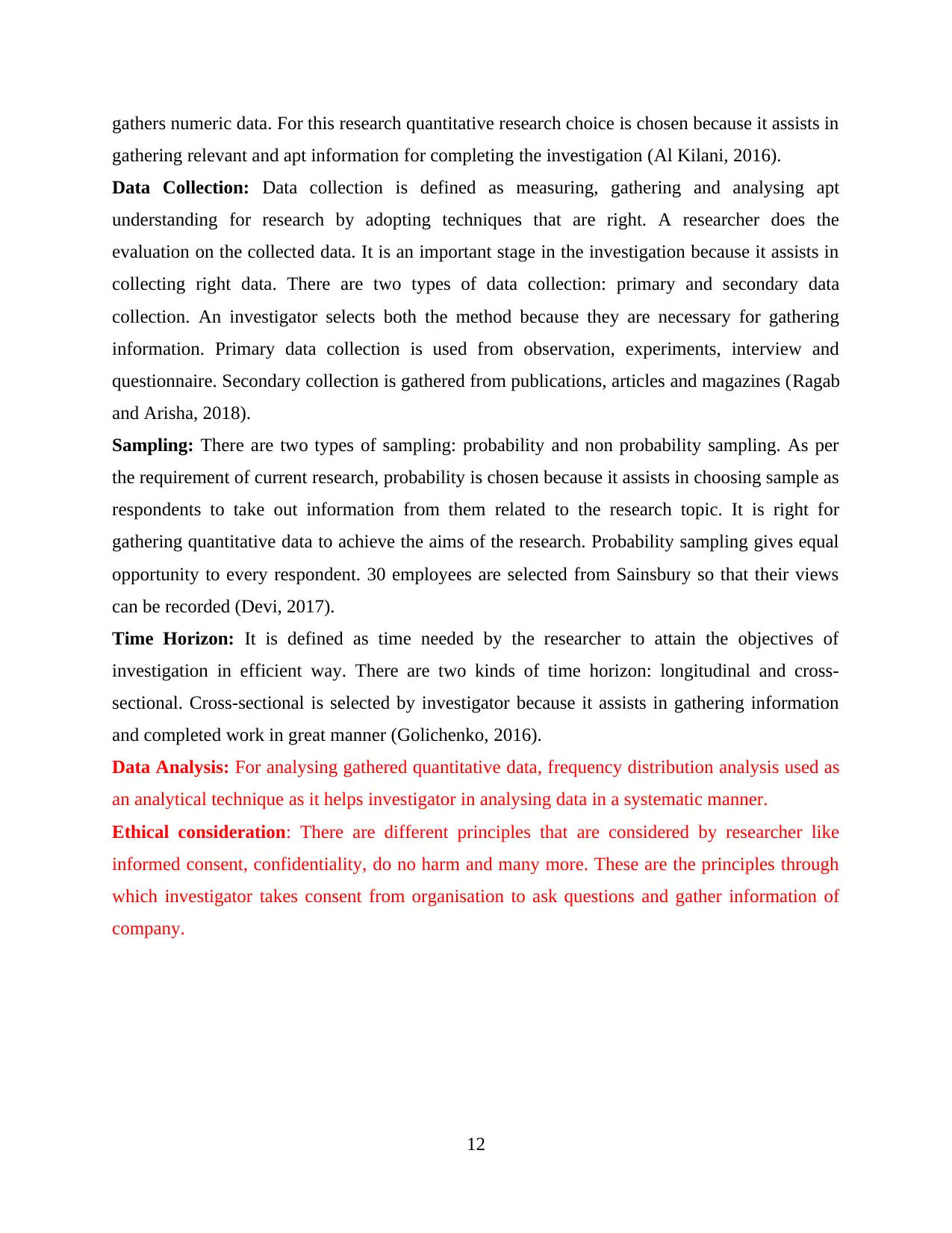
gathers numeric data. For this research quantitative research choice is chosen because it assists in
gathering relevant and apt information for completing the investigation (Al Kilani, 2016).
Data Collection: Data collection is defined as measuring, gathering and analysing apt
understanding for research by adopting techniques that are right. A researcher does the
evaluation on the collected data. It is an important stage in the investigation because it assists in
collecting right data. There are two types of data collection: primary and secondary data
collection. An investigator selects both the method because they are necessary for gathering
information. Primary data collection is used from observation, experiments, interview and
questionnaire. Secondary collection is gathered from publications, articles and magazines (Ragab
and Arisha, 2018).
Sampling: There are two types of sampling: probability and non probability sampling. As per
the requirement of current research, probability is chosen because it assists in choosing sample as
respondents to take out information from them related to the research topic. It is right for
gathering quantitative data to achieve the aims of the research. Probability sampling gives equal
opportunity to every respondent. 30 employees are selected from Sainsbury so that their views
can be recorded (Devi, 2017).
Time Horizon: It is defined as time needed by the researcher to attain the objectives of
investigation in efficient way. There are two kinds of time horizon: longitudinal and cross-
sectional. Cross-sectional is selected by investigator because it assists in gathering information
and completed work in great manner (Golichenko, 2016).
Data Analysis: For analysing gathered quantitative data, frequency distribution analysis used as
an analytical technique as it helps investigator in analysing data in a systematic manner.
Ethical consideration: There are different principles that are considered by researcher like
informed consent, confidentiality, do no harm and many more. These are the principles through
which investigator takes consent from organisation to ask questions and gather information of
company.
12
gathering relevant and apt information for completing the investigation (Al Kilani, 2016).
Data Collection: Data collection is defined as measuring, gathering and analysing apt
understanding for research by adopting techniques that are right. A researcher does the
evaluation on the collected data. It is an important stage in the investigation because it assists in
collecting right data. There are two types of data collection: primary and secondary data
collection. An investigator selects both the method because they are necessary for gathering
information. Primary data collection is used from observation, experiments, interview and
questionnaire. Secondary collection is gathered from publications, articles and magazines (Ragab
and Arisha, 2018).
Sampling: There are two types of sampling: probability and non probability sampling. As per
the requirement of current research, probability is chosen because it assists in choosing sample as
respondents to take out information from them related to the research topic. It is right for
gathering quantitative data to achieve the aims of the research. Probability sampling gives equal
opportunity to every respondent. 30 employees are selected from Sainsbury so that their views
can be recorded (Devi, 2017).
Time Horizon: It is defined as time needed by the researcher to attain the objectives of
investigation in efficient way. There are two kinds of time horizon: longitudinal and cross-
sectional. Cross-sectional is selected by investigator because it assists in gathering information
and completed work in great manner (Golichenko, 2016).
Data Analysis: For analysing gathered quantitative data, frequency distribution analysis used as
an analytical technique as it helps investigator in analysing data in a systematic manner.
Ethical consideration: There are different principles that are considered by researcher like
informed consent, confidentiality, do no harm and many more. These are the principles through
which investigator takes consent from organisation to ask questions and gather information of
company.
12
⊘ This is a preview!⊘
Do you want full access?
Subscribe today to unlock all pages.

Trusted by 1+ million students worldwide
1 out of 35
Related Documents
Your All-in-One AI-Powered Toolkit for Academic Success.
+13062052269
info@desklib.com
Available 24*7 on WhatsApp / Email
![[object Object]](/_next/static/media/star-bottom.7253800d.svg)
Unlock your academic potential
Copyright © 2020–2025 A2Z Services. All Rights Reserved. Developed and managed by ZUCOL.




